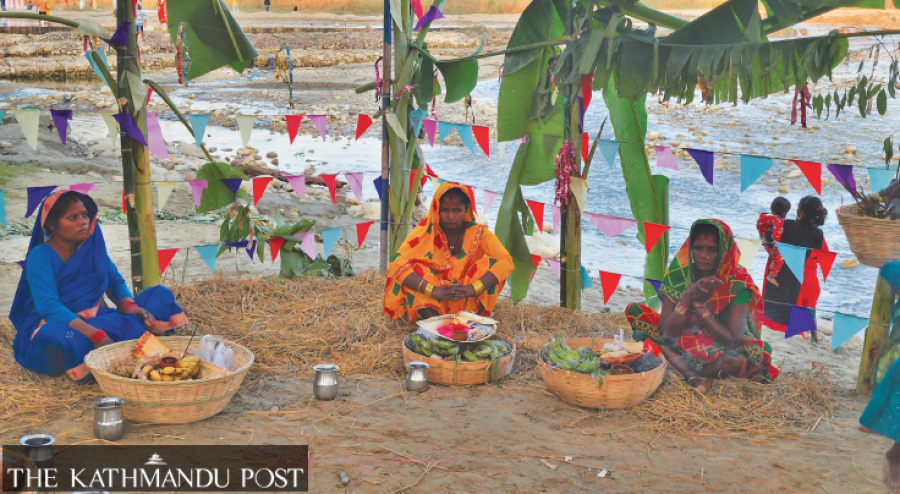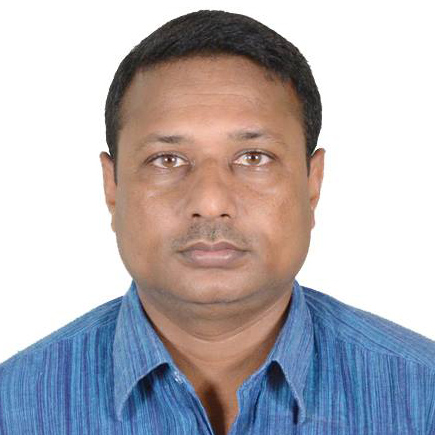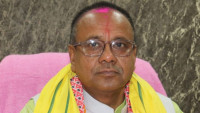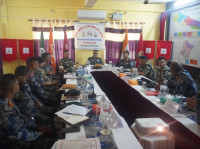Madhesh Province
Chhath’s essence is equality but Dalits still left out
For Dalits in Bara, the four-day festival was a stark reminder of the discrimination they have been subjected to for decades.
Laxmi Sah
“Come Dom’s daughter, prostrate and bring the offering basket, it is time for Arghya
Come Koiri’s daughter, bring sweet potato, it is time for Arghya
Come Ahir’s daughter, bring the milk, it is time for Arghya
Come Panheri’s daughter, bring the betel nut, it is time for Arghya
Come Mali’s daughter, bring the flowers, it is time for Arghya…”
One of the age-old Bhojpuri Chhath folk songs is a call to the community of people across all castes and beliefs in the southern Terai belt to bring their offerings to worship the Sun God. The song beckons devotees to come together to prepare for the worship of the god. Materials such as bamboo firewood and woven baskets used for Arghya—a ritual of offering prayers to the setting and rising sun—are used for prayers. It is customary for members of the Dom, Barai, Suthani Koiri, Mali and Ahir communities, categorised as Dalits, to bring their specialised offering for prayers and celebrations that follow.
The fundamental essence of this Chhath song is to bring together all communities including those pushed to the lower strata of society based on their caste. The traditional Chhath songs have different versions sung by different communities in the Terai belt.
While the Chhath songs call for equality and impartiality, the lived experiences of those from the Dalit communities are wholly different. Caste-based discrimination is rife in Nepal—from the mountains to the Terai—and never is the bias more visible than during religious festivals.
During Chhath, one of the major festivals celebrated in Nepal’s southern plains which concluded on Monday, the devotees pray by the rivers, lakes, ponds and streams. Pilgrims and worshippers pitch huge tents near the places of worship and celebrate the four-day festival. However, for Dalits in Bara, the four-day festival was a stark reminder of the discrimination they have been subjected to for decades.
The main bazaar of the historic Simraungadh Municipality in Bara, where devotees from half a dozen villages gathered to celebrate the Chhath festival on the banks of Isra Pond on Sunday, a grand and attractive tent was built for non-Dalit worshippers of all those villages. But separate tents were pitched for those from the Paswan, Domal, Chamar and other very backward Dalit communities underscoring and emboldening the segregation further.
“For decades, the Dalits have not been able to celebrate Chhath with the people of the so-called upper castes,” said Advocate Ram Babu Prasad Yadav, a resident of Kachorwa in the municipality.
In Ramnagar village in Ward 11 of the municipality, there is only one house belonging to a Dom family. Of around 150 families that reside in the village, the Dom family is the only one that has been celebrating Chhath separately for generations by fashioning their own water source at a separate place.
“For four generations, we have been celebrating the Chhath festival separately,” said Arati Mali Dom, a member of the sole Dom family in Ramnagar. “The other communities here do not allow us to pray alongside them.”
The four-day festival is dedicated to the Sun God and his wives Usha and Sangya (Sandhya), thanking them for the bountiful earth and praying for the well-being, and prosperity of their loved ones. The rituals of Chhath festival include fasting—even abstaining from drinking water—offering prayers to the setting and rising sun, popularly known as Arghya and offering prasad. The prasad prepared for this auspicious occasion includes fruits and rice pudding.
Bhojpuri literature expert Dr Gopal Thakur says that despite the message of equality in the festival, barring Dalit people from the worship areas of non-Dalits highlights the inequality in society.
“Chhath is a festival of equality. But what is being practised on the ground goes against the very essence and purpose of the festival,” said Thakur. “Chhath festival precedes caste structures; the songs are a testament to that. The beginning of the festival is marked by the songs that call for unity and equality.”
The bamboo firewoods, offering baskets and shovels made by Dalits (Dom community) are some of the essential materials used during Chhath puja but the deeply rooted caste system in Nepal has over the years pushed Dalits to the periphery of such celebrations.
Yadav expresses his displeasure over the failure of society to accept the Dalit community even though legally caste-based discrimination is a crime, and socially, immoral.
In Kachorwa village in Simraungadh Municipality, there were about 1,000 devotees gathered at the ghats near Dinbandhunath, Parasnath and Aduwa rivers where people from the so-called “upper caste” observed the Chhath fast together in one tent but no one from the Dalit community was allowed inside.
The narrative is not limited to only a couple of villages in this particular municipality in this particular district. Dalits in other neighbouring districts are also segregated from the non-Dalits and have been forced to celebrate every Chhath separately for generations.
Vice Chairperson of Baragadhi Rural Municipality Lakshmi Devi Rae, a leader of the Dalit community in her area, says that lack of awareness in society is one of the major reasons behind the practice of discrimination.
To bring an end to the long-practised discrimination, Thakur says Dalits must be prepared to struggle for equality during Chhath. “Dalits should also be mentally prepared and struggle for equality to celebrate Chhath alongside non-Dalits in future.”
In Baragadhi Rural Municipality, the Dalit community that used to celebrate the Chhath festival separately until a few years ago now celebrates together with non-Dalits after a long struggle for equality.
“After years of struggle we were finally able to break the tradition of segregation in our community,” said human rights activist Sikendra Paswan. “Now we celebrate Chhath under a single tent.”
Paswan says that Dalit communities in other areas should also fight for equality to celebrate Chhath with everyone in the community.
Champa Devi Chaudhary, aged 66, from Madhuban, Karahiyamai Rural Municipality-1, says Dalits and non-Dalits performing Chhath puja in separate spaces is not rooted in discriminatory practices but over time the practice took the form of discrimination. “Every community in the Terai has its own native way of observing Chhath. They have their own versions of folk songs too. People offer what their community produces to the Sun God and every community has different offerings. This is how the practice of different communities observing Chhath in separate spaces came about,” she said. “But over the years, the segregation of worshippers has taken a different meaning altogether. It was never meant to be a discriminatory practice. This festival allows every community to create their own ecosystem and provide a helping hand to others.”




 16.12°C Kathmandu
16.12°C Kathmandu












